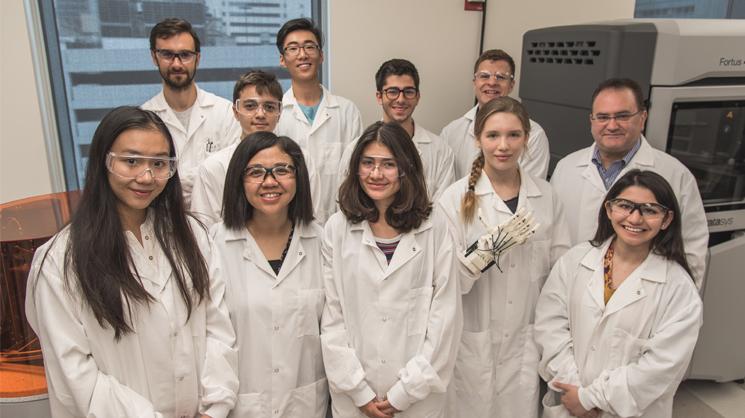The Rice University Biomaterials Lab hosted a weeklong internship in three-dimensional printing technologies for six high school students in conjunction with the Awty International School Houston.
Three-dimensional (3D) printing is a growing area of medical research as more therapeutics, surgical procedures, and medical devices are taking advantage of its advanced capabilities. Rice’s Biomaterials Lab, which is a member of the Center for Engineering Complex Tissues (CECT), specializes in the latest technologies in 3D printing.
Among the many 3D printing applications, the technology enables researchers and clinicians to design custom implants and prosthetics for patients, as well as rapidly design and prototype tools that can be used during surgical procedures. The student interns explored several of these topics culminating in the fabrication of a functional, customizable prosthetic hand.
“We were delighted to have the students visit the lab for the week,” said Biomaterials Lab Director Antonios Mikos, who is also the Louis Calder Professor of Bioengineering and Chemical and Biomolecular Engineering and director of the CECT at Rice. “It is a valuable opportunity for them to participate in our research efforts and also a great opportunity for the members of our laboratory to utilize their teaching skills.”
Mikos and Tairong Zheng, a teacher and academic coordinator at Awty International’s Upper School, established the internship program, which is also part of the CECT’s educational mission. Tony Melchiorri, associate director of the Biomaterials Lab, organized the internship with the help of bioengineering postdoctoral fellow Luis Diaz-Gomez, and bioengineering doctoral graduate students Sean Bittner and Marjan Majid.
“The students got to see how they can combine the topics they learn in school to these technologies,” Diaz-Gomez said. “For example, they could see how physics affects the medical imaging through x-rays, how we use mathematics to measure and design devices, and how we use biology to take advantage of cells and tissues in our bone regeneration grafts.”
Diaz-Gomez and the rest of the group instructed high school students in experiments and exercises used in the clinic and medical research. For example, students applied medical imaging techniques to capture a 3D model of an object that they could modify digitally and then print three-dimensionally. They also created scaffolds intended to foster cell and tissue growth out of gelatin and alginate, two naturally derived biomaterials, and they learned how to fabricate custom-designed artificial bone grafts.
Participating high school students included seniors Sebastian Chenin, Ivy He, Lauren Howe, and Petros Zombanakis, junior Joe Li; and sophomore Kaia Luik.
Capping off their experience at Rice’s Biomaterials Lab, the high school students 3D printed and assembled functional prosthetic hands based off designs provided by E-Nable, a global charity that coordinates with volunteers to 3D print prosthetics for children all around the world. Mikos and Melchiorri said they hoped the students now have a taste for using cutting-edge 3D printing technologies to address real-world problems like limb loss.

